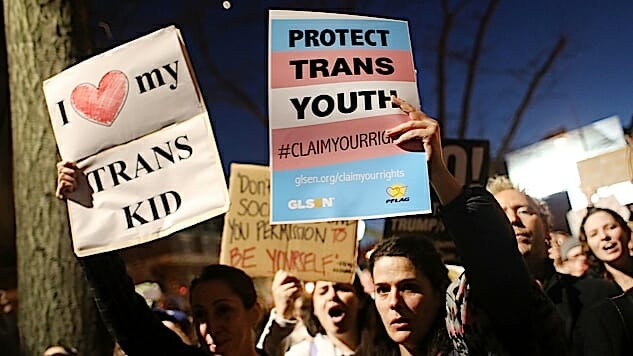Anti-Transgender Legislation Devastates Trans Children—Even When It Fails
Photo by Spencer Platt/Getty
“I’ve dealt with bullying my whole life, and now I worry that my own state lawmakers are bullying me as well.”
—Skye Thompson, 15 years old, speaking to the N.C. General Assembly in March 2016, hours before the passage of House Bill 2
![]()
Dr. Michele Angello is a college professor, author, and psychologist working in the Philadelphia area. She has run her private practice for nearly 20 years, and she estimates that more than 90 percent of her current clients are transgender, gender non-conforming, or exploring gender in some way. About half of them are under 18, and because she conducts remote sessions, they come from 30 states and ten different countries. Even for someone with her extensive experience, the realities of life for transgender children can be staggering.
“The number of things that a young trans person has to think about that a cisgender person just takes for granted is just enormous,” she said. “For instance, most of us who are not trans don’t think about fertility issues when we’re seven or eight, but sometimes trans kids do. They’ll say ‘oh my gosh, if I want to have biological children, how does that work?’ I have that conversation with seven-year-olds all the time.”
These struggles are compounded by the current American political climate. Angello remembers, in particular, working with four transgender youth from North Carolina in the aftermath of House Bill 2—the infamous “bathroom bill” mandating that (among other things) individuals must use the public restrooms and changing facilities that correspond with the gender listed on their birth certificates. The act extended to restrooms at public schools, which meant that transgender students who used the bathroom that matched their identity were now in violation of the law.
Two of Angello’s North Carolina clients, both in middle school, came from families that could afford to send them to welcoming private schools, and though this move didn’t mitigate the discrimination that they experienced in other walks of life, it allowed them to sidestep the worst impacts at school. For the two others—both girls who had transitioned at a young age, and had been using the women’s restroom for years—this was not an option, and the administrators at their public schools, fearing legal trouble, refused to allow them to continue using the women’s bathroom.
In response, the girls settled on different solutions. One, after fighting the school and getting nowhere, eventually gave in and began to use the bathroom in the nurse’s office—an inconvenient fix that required her to be dismissed early from classes, drawing unwanted attention to herself at a time of heightened state-wide discrimination.
For the other, the prospect of using the men’s room was so uncomfortable and dispiriting that she simply stopped using the school bathroom at all. She would force herself to hold it during the long daytime hours rather than subject herself to a worse misery. In order to make it through the day, she stopped drinking anything until she got home.
![]()
Stories like these illustrate the horrific psychological and physical impact that anti-transgender legislation can have on trans youth when it’s actually enacted, though they don’t begin to encompass the worst outcomes, which include physical assault, mental illness, and suicide. But the effects are no less devastating when political attempts to curtail trans rights fail—which, quite often, they do.
The state of anti-trans lawmaking in the United States is something of a mixed bag. The sheer number of attempts to legislate against trans people specifically has been at an historic high for several years. The Human Rights Campaign found 44 anti-transgender bills in 2016, and the National Center for Transgender Equality identifies 23 bills and ballot initiatives across 13 states in the 2018 legislative session.
They fall into several broad categories—bathroom bills are especially popular among Republican politicians, who believe they can scare voters by invoking the specter of trans women assaulting young girls in restrooms, or sexual predators using transgenderism as a cover to do the same. (Such incidents in public facilities are exceedingly rare to nonexistent, and the far more common outcome is transgender people being assaulted when forced to use the bathroom of their sex assigned at birth.) There are also bills that attack trans healthcare rights, state bills that seek to override anti-discrimination laws in cities or towns, and discrimination carve-outs that allow private businesses to discriminate through religious exemptions—think of the Colorado baker who didn’t want to serve gay people.
These acts are universally introduced by Republicans, and they are particularly en vogue today for two reasons. The first is the increased visibility of America’s trans population, which has come with many benefits, but also made them a target for conservative politicians. Even ten years ago, specific anti-trans legislation was almost unheard-of. Anonymity had its drawbacks—the lack of national awareness meant it was hard for the trans community to organize and achieve anti-discrimination protection along with other marginalized groups—but they were rarely attacked directly.
Mara Keisling, the founder of the National Center for Transgender Equality and a trans woman, gives the Internet credit for enabling a broader transgender movement to coalesce.
“I’m 58 years old, and people of my age group will always tell you they thought they were the only one well into adulthood,” she said. “I knew there were others, but there was no way to interact with them until the Internet solved it…I don’t have any proof of this, but I believe when I graduated from high school in 1977, there was not an out transgender student in public school in the whole country. Not a single one.”
Now that everything has changed, it allows for activism and public recognition on a scale not previously possible. But the recognition comes with a price, which is illustrated in the sheer number of anti-transgender bills, many of which target America’s trans youth.
Some are particularly cruel, as in the Ohio bill that would require teachers, guidance counselors, or health care professionals—under penalty of a fourth-degree felony—to notify parents if their child so much as questioned his or her gender identity. Not only would this law “out” transgender children against their will, but it could also legally deprive them of a sympathetic ear in a time of great struggle. (The bill is currently in committee in the Ohio House.)
“It means these kids are targets,” Keisling said. “In the ‘60s and ‘70s I could just hide, because I had to hide. There was no other option, and everybody thought we were the only ones in the world. Everything has changed for kids now, and some of it is really great and some of it is less great.”
The second reason for the recent surfeit of political attacks on the trans community is far simpler—with the Obergefell v. Hodges ruling in 2015, the Supreme Court held that same-sex couples had a fundamental right to marry by virtue of the Fourteenth Amendment. This, at least temporarily, deprived Republicans across the country of a favorite target, and their longstanding fight against gay marriage was dead on arrival. They needed a new scapegoat, and the transgender community looked like an easy target.
“Marriage became no longer a wedge issue, so Republicans thought, ‘well, trans people are unpopular, and they don’t have any friends, and we’ll attack them,’” Keisling explained. “And they’ve now found out that we’re not unpopular, and we do have lots of friends who will support us and stand with us.”
That’s the silver lining in the cloud of anti-transgender legislation: The overwhelming majority of these efforts fail. Of the 23 attempts listed by the NCTE’s website, 21 have been defeated, one is a pending bill, and one is a ballot initiative that will be voted on in November in Massachusetts.
Those last two, the only non-failures, are instructive—the bill is an attempt by Republicans in the Pennsylvania state legislature to deny transgender youth coverage under the Children’s Health Insurance Program for trans-related services. After a failed attempt to attach this measure to a broader CHIP bill, it has been re-imagined as a standalone act that is currently floundering in the House. The Massachusetts ballot initiative is a push to repeal a 2016 state law protecting transgender people from discrimination, and the repeal side is currently polling around 20-25 percent.
So it’s possible, even likely, that every anti-transgender political maneuver tracked by NCTE will fall short this year, and what’s remarkable is that most bear the same epitaph: “Died in committee.” That means they never came up for a full vote, and in most cases it was Republicans themselves in state legislatures who made sure they never saw the light of day—a purposeful suppression designed to limit media coverage.
In other words, the GOP as a whole has realized that discriminating against trans people is not a winning issue, and they’ve realized it far faster than they ever did on the subject of gay rights. The fallout from HB2 played a significant role—many public and private organizations boycotted North Carolina, including the NCAA, and the potential economic impact on the state was estimated at $3.76 billion over 12 years. HB2 is also seen as a leading cause of Republican Governor Pat McCrory’s defeat in the 2016 election, in a cycle when the rest of the party, Donald Trump included, scored big victories across the state.
“I recently ran into a very prominent southern politician who is not on our side,” Keisling said. “And he told me, ‘we all know what we just watched in North Carolina, and this is not a winner for us.’ And what we’ve heard in 2017 and 2018 during the state legislative sessions all over the country is representatives and governors saying, ‘holy crap, we do not want to see in South Dakota what they did to North Carolina.’”
There are exceptions. The governor and attorney general in Texas are planning an assault on transgender rights in 2019. At the federal executive level, where there are fewer impediments to unilateral action, Republicans have wasted little time. The Trump administration withdrew an Obama-era guidance that the protection of trans students in schools—including access to the appropriate restrooms and changing facilities—should be covered under Title IX. One year ago, Jeff Sessions pulled a similar move in the realm of employment discrimination, writing in a memo that a 1964 civil rights law “does not encompass discrimination based on gender identity per se, including transgender status.” And Trump attempted an ill-fated trans military ban that was overturned by the courts, but is potentially being enforced anyway.
Writ large, though, there is cause for optimism—most anti-trans legislation never becomes law.
But the deeper truth is that when it comes to the psychological impact on trans children and teenagers, even the failures do lasting damage.
![]()
Claire is a transgender woman in her mid-20s from the Raleigh-Durham area of North Carolina, and she asked to be identified by a pseudonym to protect her anonymity. She came out as transgender in 2016 partially as a result of the self-examination prompted by HB2.
“It made me go back to feelings I had put aside and not really analyzed fully because I was scared of them or uncomfortable with them,” she said. “Especially just hearing the rhetoric on the news, or anything that [Gov.] McCrory said, and I would be getting angry and frustrated and thinking, how dare they do this to…well, them.”
It wasn’t long for Claire before “them” became “me.”
“I was up really late one night after a bout of insomnia,” she remembered, “and I just couldn’t stop thinking about it. And then in my mind I was like, ‘well, what if you are trans?’ I was sitting there and then maybe five minutes later, I was like, ‘shit, I’m trans.’”
Since then, Claire has come out in almost every facet of her life, from friends to family to her community, and began medically transitioning in 2017. There’s just one exception: Claire is a high school teacher, and she has not yet come out at her job.
In 2017, the General Assembly reached a compromise settlement to “repeal” HB2, but the legislation they came up with, HB142, was seen by many as worse than the original. In almost every way, the bill fails to enact real protection for trans people, and included what Slate called “a years-long moratorium on local LGBTQ nondiscrimination ordinances” that is set to expire in 2020, but could easily be extended. It has left Claire feeling that her job could be vulnerable if she came out.
“There’s not much protecting workers’ rights, especially LGBT workers’ rights, so technically I could get fired for being trans,” she said. “Especially with teaching, there’s such a possibility for one parent to raise a stink, and the school could decide it’s too much of a hassle. And I rather like my health insurance.”
For now, Claire leads what she calls a “double life.” From her vantage as a teacher, she has watched co-workers make subtle comments about gender, much of it inspired by the constant media coverage of HB2. They make cracks about “identifying as a helicopter” (a meme-adjacent “joke” meant to dismiss gender identity) or sarcastically ask “did you assume my gender?” as a vague way to minimize the very concept of transgenderism. Because Claire is intent on protecting herself and her job, she doesn’t feel comfortable correcting them in her guise as a male teacher.
Nor was she keen to engage her students when she saw them uncritically mimic some of the anti-trans rhetoric they were hearing from parents and conservative media during the height of HB2. They would say things like, “I don’t want sex predators in the bathroom anyway,” and when the NBA All-Star game moved away from Charlotte, certain students were particularly incensed and blamed trans people—succumbing to what Claire called “quick, easy, emotional bait.” When she did have discussions, it was difficult to make progress—the students were stubborn about analyzing their reactionary beliefs. As Claire described it, their mindset went no deeper than, “gay people are gross, trans people are worse.”
Despite the fact that HB2 was one of the “successful” anti-trans bills, at least for as long as it lasted, the reaction it promoted is common wherever such legislation appears, regardless of the final outcome.
“It’s about the fear, and the emboldened nature of some of the folks who have recognized that it’s safe to be a bigot,” said Dr. Angello. “In the sixth months after the presidential election, I had more young people in particular hospitalized for mental health issues, suicidality, or just having a difficult psychiatric time than I have in my entire 20-year career with trans people.”
According to her, there are a few negative factors that converge in the presence of political opposition. The first is fear—the idea that even if things aren’t bad now, they could get really bad. The second is the heightened focus on trans issues, which leads to increased bullying from other children and adults. (She recounted a story about a man in central Pennsylvania who spent weeks outside an elementary school holding signs to specifically protest one transgender student who wanted to use the proper bathroom.) Third, there’s the sense that any progress has been reversed, taking with it the hope for a comfortable life free from constant hyper-vigilance.
“With this election,” she said, “they felt like they were making headway, and it didn’t even feel like a slap to the face. It felt like a punch to the face.”
She likened it to Lucy pulling the football away from Charlie Brown, and it holds true anytime anti-trans legislation is introduced. To the teenager who attempts suicide, or is committed to a hospital, it is little consolation if the discriminatory bill eventually fails, or if the trans military ban doesn’t stand up, or if the Republicans lose an election two years later. To a large extent, especially for children, the damage has been done.
“They don’t necessarily have the emotional maturity to go through these things,” Claire said, having worked with teenagers for years, “but they do have the emotional maturity to hurt.”
Keisling, the executive director of the NCTE, concurs.
“These adolescents, they see the political culture,” she said. “It is so hard being anybody in the world right now, but being a child who is different, when society is telling them to be ashamed of themselves, is just so hard.”
She pointed specifically to Jeff Sessions withdrawing the Title IX guidance, which, though it may not have an immediate practical impact in most schools, fundamentally broadcasts the message that administrators and teachers do not have to treat trans students with respect. For the most problematic schools, these signals from above can lead to day-to-day changes that make life miserable for a marginalized group like trans children.
And these children are already at enormous risk. Among the most important tasks Keisling and the NCTE undertake is the U.S. Trans Survey, which provides data that is used in almost every story about transgender issues, including this one, and which lays a foundation for journalism, research, and activism. The last survey, in 2015, reached almost 28,000 trans people, and the mental health findings were harrowing—almost 40 percent will attempt suicide in their lives, roughly nine times the rate of the U.S. population. Incidents of depression, anxiety, and suicidality are similarly high.
Trans adolescents are particularly vulnerable due to the emotional makeup of teens in general, and the fact that the emergence of secondary sexual characteristics with puberty can be a source of trauma—as Dr. Angello noted, these unwelcome changes are often perceived as a betrayal from within the body. Considering this storm of risk factors, it’s no exaggeration to say that the additional stress of anti-trans political legislation targeting trans youth has been psychologically ruinous, and in some cases fatal.
![]()
The election of Donald Trump gave rise to bigotry in soft and hard forms around the country (or at least emboldened the existing bigots), and has produced in marginalized groups a muted sense of terror. The trans population is no exception, as Dr. Angello’s experience with post-election psychiatric hospitalizations proves. Even those who react to anti-trans legislation by fighting back are not immune to great stress.
“A lot of the people who get mobilized in those situations are not experiencing just good energy,” Keisling said. “They become exhausted, they become terrified.”
She told me of a 55-year-old trans activist who left his job to go back to school, and who stopped working in his school’s cafeteria after a bathroom bill was introduced. Instead, he’d sit in his car until the last minute, attend class, and then hurry back to his car. He felt as though his legislature and even his ministers were telling the cisgender population that trans people shouldn’t be out in public, and he was afraid that somebody would attack him.
Claire relates to that feeling.
“Every time I see news about a new anti-trans measure,” she said, “specifically with health insurance or the trans military ban, I get this nauseous feeling. My brain starts thinking, ‘this is the start.’ I have had—I’m not going to say panic attacks—but close to that. It’s a feeling I’ve had since Trump was elected, this concern that any day now there’s going to be legislation that criminalizes me just existing out in the world.”
Confronting these thoughts in lonely moments can be just as difficult, or more so, than the public bullying with which every trans person is forced to become familiar.
“I experienced a certain amount of transphobia on the streets, yes, but the absolute worst times for me were when I was alone with this constant self-doubt, and second-guessing, and fear of the unknown,” Claire said. She referenced the Ohio bill that would compel school officials and health care professionals to play ‘trans police’ and notify parents of their children’s struggles. “Knowing that there are kids out there who have to keep themselves hidden or the people they trust are legally obliged to tell on them, it’s terrifying,” she said. “And that’s the point—to freeze, to limit the amount of trans people in public.”
Dr. Angello has noticed a worrying trend in how the parents of trans children first approach their new reality. For years, they would ask her to “fix” their children, but education and awareness slowly changed the paradigm, to the point that many parents would begin asking how to help their children explore their gender. There are still a healthy amount of supportive parents today, but in the current political climate she’s noticed a re-emergence of what she calls the “skeptic parents” who are influenced by hate groups and pseudoscientific gender concepts. These people believe their child needs to be repaired in some way.
She believes that the high incidence of mental illness in trans people, while influenced by dysphoria, would not be nearly as pronounced without the prevalence of discrimination and harassment.
“I have said to so many clients, if I could get the entire world to come to my office and be educated, you could stay home,” she said.
To Angello, the perception of trans people could undergo a drastic shift if the cisgender world would take one extra step and ask the right questions about who trans people really are, rather than accepting propaganda at face value. But too often, those questions go unasked, and political institutions from the federal level downward set the tone for how society treats trans people.
![]()
Even subtle indications of bigotry can have devastating effects. Angello spoke of one child from a Christian family who continued to attend church after coming out. When Trump was elected, and in the midst of local anti-trans legislation, the family began to notice covert messages coming from the pulpit, all suggesting that the current political climate was a good thing for Christians.
The child felt bullied by the church, and had a pressing question on the next visit to Dr. Angello’s office:
“If God doesn’t even love me, what’s the point?”
That child, mercifully, is still alive. In the age of anti-trans legislation, too many are not.







































